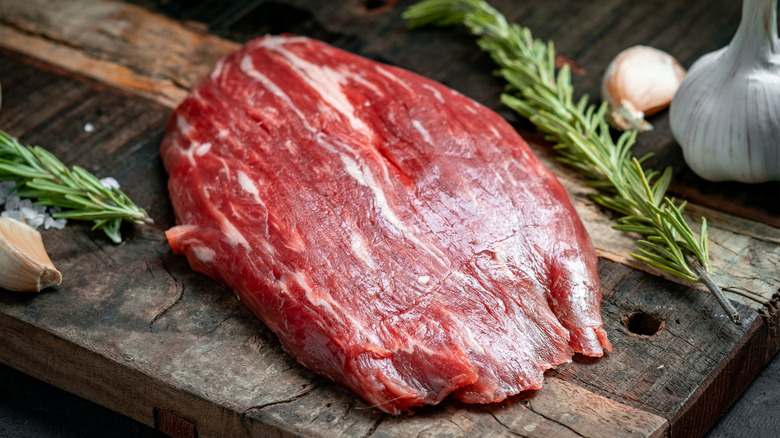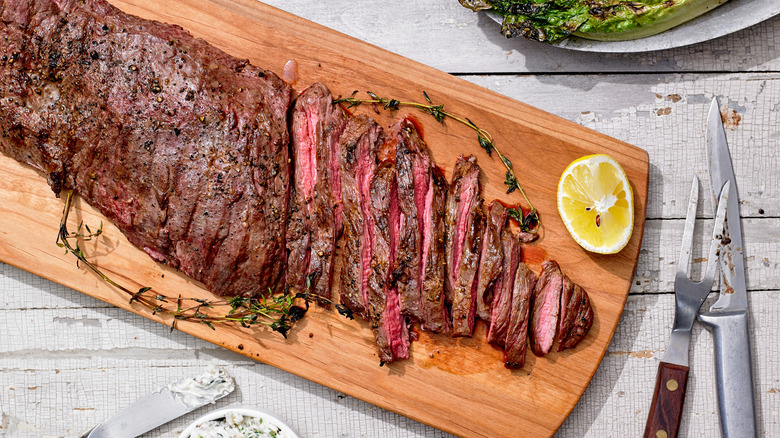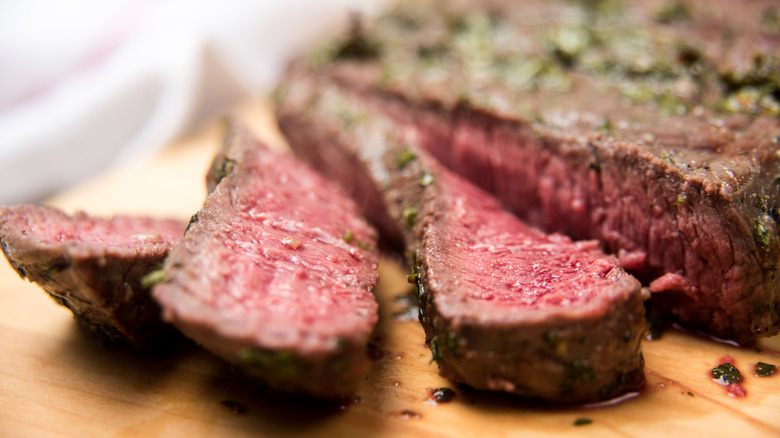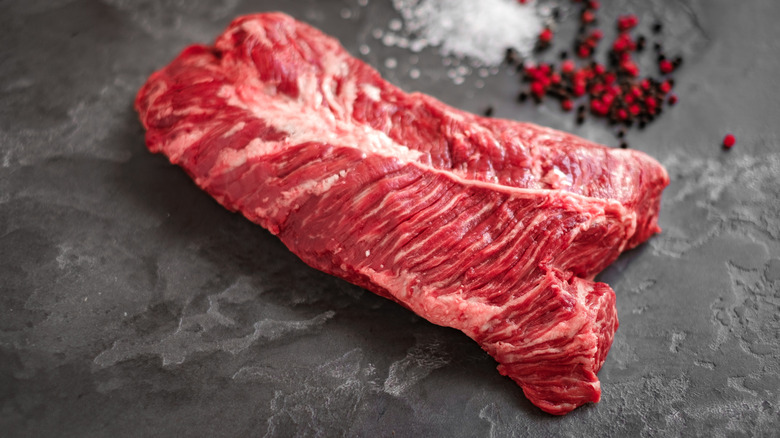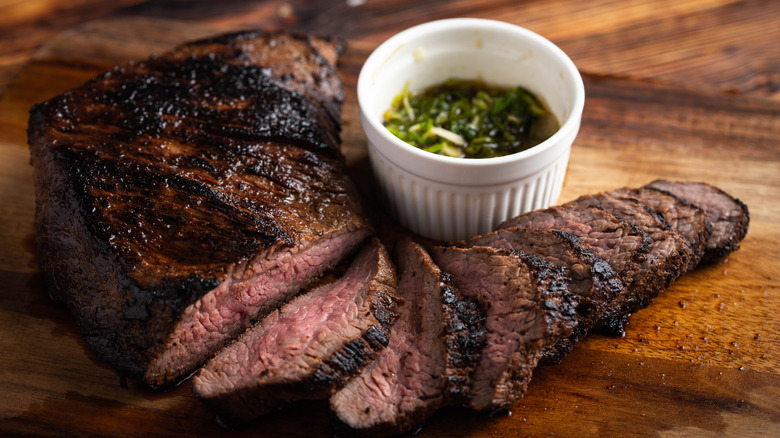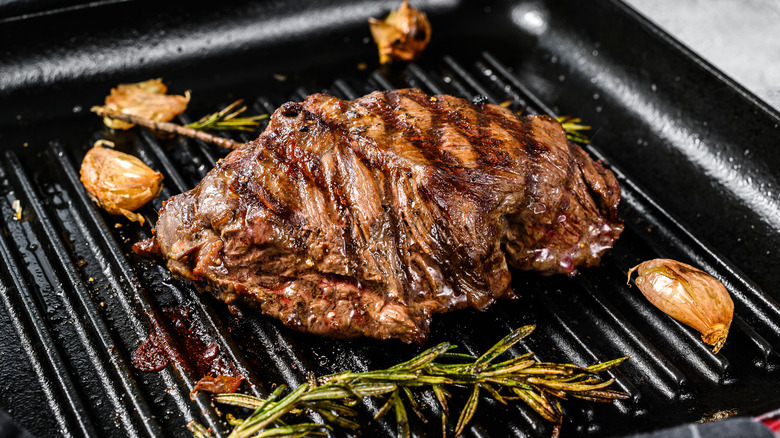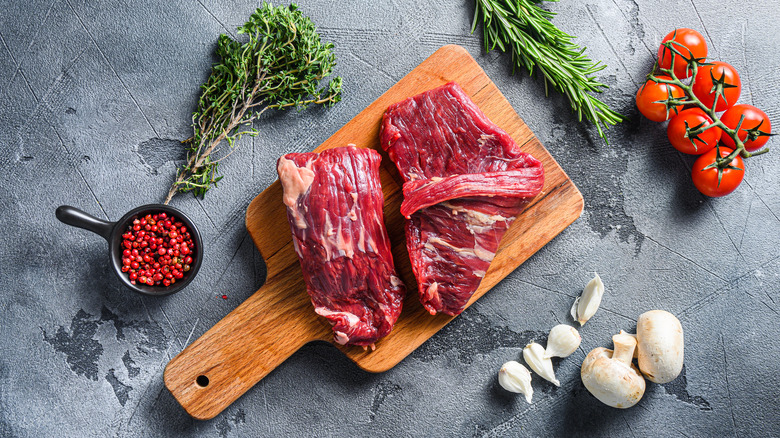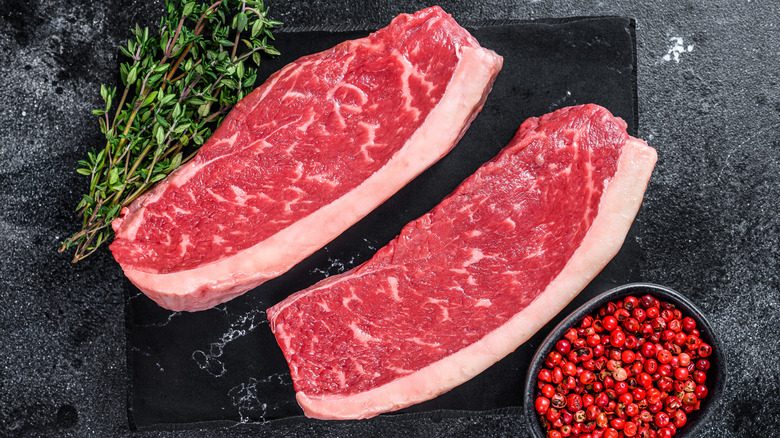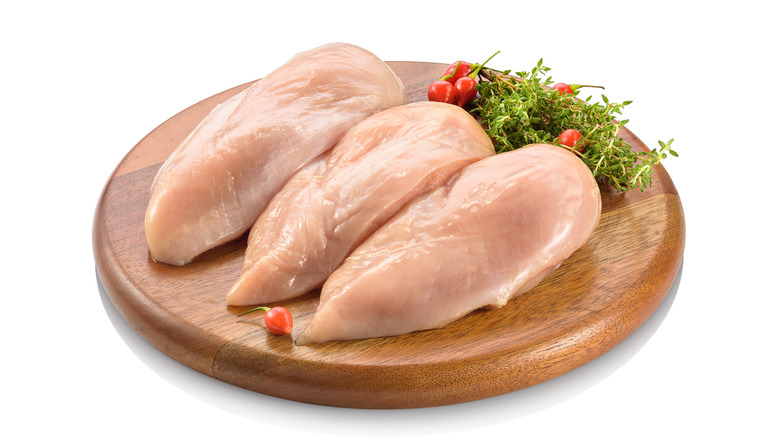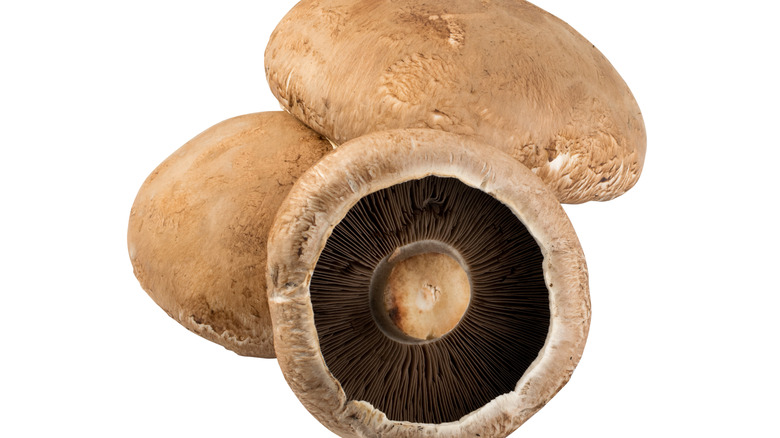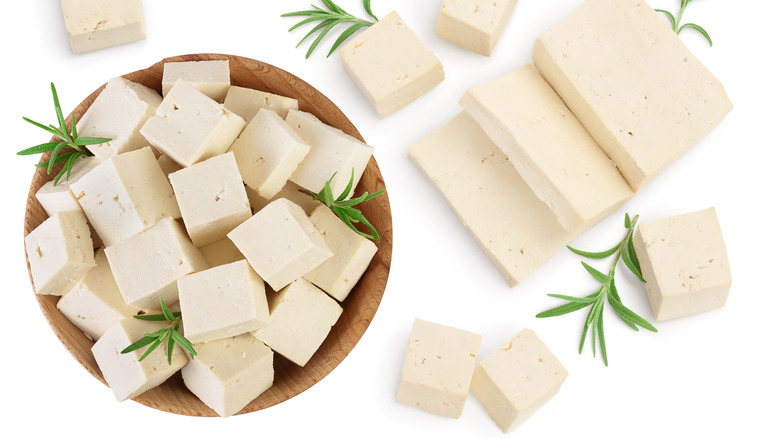10 Best Substitutes For Flank Steak
Once upon time, flank steak was considered a lowly cut of beef, often discarded or ground into hamburger. By nature, it's tough. And a tough cut of beef used to be synonymous with an inexpensive cut of beef (via The Atlanta Journal-Constitution). As its name suggests, flank steak comes from the cow's flank — or, the muscle located on the belly or underside of the cow, below the loin and rib cage.
While flank steak had a loyal fan base in Tex-Mex and Southwest cooking styles, home chefs in other parts of the United States were puzzled over how to prepare it. Toss it on the grill and you'd end up with a tasteless, chewy hunk of meat. Make the mistake of cutting it with the grain and you may as well be serving shoe leather. Then along came the Food Network with its roster of cooking shows and charismatic chefs introducing regional flavors and specialities to a national audience, and we got more ideas.
In the case of flank steak, we learned how to marinate and slice the bargain-priced cut of meat to make sizzling fajitas and overstuffed burritos. Gradually, we expanded our horizons to incorporate flank steak into Asian-inspired dishes like Mongolian beef and Italian braciole (via Taste of Home). And the rest, as they say, is history.
Fast forward a few decades and that once lowly cut of meat with an equally low price point is now one of the most popular beef cuts in the United States. In most major markets, you'll find it priced at, or near, the cost per pound for grill-favorite sirloin strip steak.
It's good to know you have options when it comes to buying meat that's affordable and tastes great. A good idea is to look for sales and ask your butcher for suggestions — even grocery store meat-cutters (many of them, anyway) are willing to offer advice about choices and substitutes for specific preparations. And in a pinch you can follow this guide with 10 worthy swaps for flank steak that cook up and taste just as good.
1. Skirt Steak
Even though It's not quite as lean, skirt steak is a common stand-in for flank steak, according to eHow. It comes from the plate of the cow, which, as Texas Monthly says, is located in the center of the steer just below the ribeye. It's a good alternative for flank steak when the preparation calls for grilling, broiling, or cooking over high heat in a cast-iron skillet.
Although it has a higher fat content, skirt steak still has a tendency to get tough when it's prepared. For best results, marinate it before cooking, be careful not to overcook it, and always slice against the grain. When done right, it's a great replacement for flank steak in dishes like fajitas and stir fries. Because it's a thin cut, Bon Appétit suggests skirt steak as a quick-cooking option when you're craving beef, but short on time. Coat the steak with olive oil, place it into a hot skillet, cook for two to three minutes per side, let rest for 10 minutes, and slice against the grain (we can't stress this enough) into thin strips.
2. Top Round
If you've ever seen a steak labeled London broil at the grocery store, you were probably looking at either a flank steak or a top round cut (via eHow). That's because London broil isn't a specific cut of meat. Instead, it's a broad term that applies to a whole family of steaks; namely, cuts that are usually lean and often tough. And according to Reluctant Gourmet, London broil is actually a style of cooking. So, if you stroll into your local butcher shop and ask for London broil, it's probably a toss-up whether you'll get flank steak, top round, or some other relatively tough cut of meat.
So, it can be surmised that flank steak and top round are interchangeable in many preparations — especially any recipe involving a marinade. Interesting side note: London broil is actually not from London. Early references suggest it originated in the 1930s in Philadelphia, Pennsylvania.
3. Hanger Steak
Another good substitute for flank steak is hanger steak. This style is usually cut thin, like flank steak, but it has a higher fat content making it just a little bit more tender. According to eHow, hanger steak comes from the underside of the cow, near the loin. The best preparations include basting with a marinade, so in this case, hanger steak is a good stand-in for flank steak when used in dishes like fajitas.
If you decide to grill it, be careful not to go over about two minutes per side, unless you like your steak served tough. Sometimes called hanging tender (via My Recipes), hanger steak has gained a following in the United States over the past decade or so. Prior to that, it was sometimes called the "butcher's cut," a reference to its popularity among butchers who prized it for its impressive flavor long before home cooks — or even professional chefs — were in on the secret.
4. Tri-Tip Steak
Tri-tip steak is another suitable and affordable swap for flank steak. The triangular, boneless cut of beef comes from the bottom (aka the tip) of the sirloin. Also known as triangle steak, according to eHow, tri-tip steak has the benefit of an easily trimmable fatty edge — though, for the best flavor, do the cutting after cooking.
Well-known in California Wine Country as the main ingredient in Santa Maria-style barbecue (basically, sirloin roasted over a red oak fire), tri-tip traces its roots to the mid-20th century when a local grocer, Bob Schutz, decided to showcase the cut as steak. Before that, it was commonly ground or used as stew beef.
According to Santa Maria Valley, the cut was long considered a throw-away for a few reasons including the fact that, because there is only one tri-tip per side of beef, grocers thought it would be a waste of space in the display case. Thankfully that opinion has changed over time and this cut is now more readily available.
5. Flat Iron Steak
Gourmet Sleuth suggests switching in flat iron steak — a top blade cut — for flank steak when you need a good substitute. According to Food Fire Friends, top blade steaks come from the chuck primal, or shoulder, of the cow. Taking it a step further, a flat iron steak is a specific cut of blade steak. It's attached by fatty connective tissue to the top blade roast.
Food Fire Friends further explains butchers remove that connective tissue to reveal two separate cuts of meat — the top blade steak and the flat iron steak. The average flat iron steak is about one-inch thick and weighs about eight ounces. It gets its name from its resemblance to old-fashioned flat irons that were heated on a stove and used to press clothes. It's a rich, flavorful, tender cut of meat, and Beef It's What's For Dinner points to it as a good choice for grilling. It also works well in slow-cooker recipes.
6. Flap Steak
Flank steak and flap steak are interchangeable in many recipes, according to Gourmet Sleuth. A flap steak is a thin, somewhat lean cut of meat that, like flank steak, comes from the belly of the cow. (Another note: Flap meat cut into cubes instead of steaks is called sirloin tip.) Also like flank steak, it has a coarse grain, so it takes well to preparations involving marinades.
While it's a good choice for marinades, flap steak also works well on the grill where high heat is the key to its success. It cooks quickly, but some grill masters like it for that very reason, intentionally charring the edges to get crispy bits of beef that border the soft inside. If you choose to experiment with charring, keep a close eye on the internal temperature of the steak. If it's undercooked, it tends to be too chewy. Overcooked, it's unpleasantly dry.
When you're ready to serve, slice the steak across the grain into thin strips.
7. Top Sirloin
Weber Grill Review gives a nod to sirloin steak as a suitable substitute for flank steak, but reminds its audience there are two kinds of sirloin — top sirloin and bottom sirloin. It's recommended to choose top sirloin when you're replacing flank steak. According to Chef's Resources, top sirloin is found just beneath the tenderloin. It's much more tender than bottom sirloin, which is usually ground, stewed, or braised. Other names for top sirloin include top butt steak, center cut sirloin, and hip sirloin steak.
It works well in recipes calling for rubs or marinades. It's also good in stir-fries. Gourmet Sleuth says top sirloin steak ranks among the most affordable cuts of meat. It holds up well for grilling, even without a marinade, but be careful not to overdo it. Aim for a medium-rare temperature. Once done, let the cooked steak rest, then cut into slices on the diagonal.
8. Chicken Breast
Loving the recipe, but not feeling like beef? Consider switching in boneless, skinless chicken breast for a change of pace. According to Recipe Marker, chicken breast can stand in for flank steak in all kinds of recipes including stews, stir fries, and grilled preparations. It's low in fat and high in protein, and is quick to absorb the flavors of the dry rubs and marinades you use to cook with it.
Echoing the choice, eHow points to chicken breast as an especially good option to replace flank steak in dishes that call for sautéed protein with vegetables. Substitute Cooking points out that boneless chicken breast is a great go-to replacement for anyone trying to limit their intake of red meat, noting it works really well with Mexican seasonings in dishes like fajitas, tacos, and burritos.
A quick word of caution: Be extra careful not to overcook boneless chicken breast. It can quickly go from just-right and juicy to chewy, dry, and tough.
9. Portobello Mushrooms
If you're looking for a vegetarian alternative to flank steak, portobello mushrooms are tasty and meaty. Though they aren't likely to fool die-hard meat eaters regardless of preparation. Like flank steak, portobello mushrooms are quick to absorb marinades. In addition to their meat-like texture, they have a satisfying, earthy flavor. And they're big, with caps averaging five to six inches in diameter (via Specialty Produce), a size that could match up to some cuts of meat.
These types of mushroom caps are smooth and range in color from beige to brown with fleshy, dark brown gills on the underside. Stems are dense and fibrous. Portobello mushrooms are extremely versatile and even stand up to grilling. Oh My Veggies suggests substituting portobello mushrooms for flank steak in fajitas. They're also good in tacos, enchiladas, and mushroom bourguignon.
It's interesting to note that, due to their size and texture, portobello mushrooms were widely unheralded in the United States until the 1980s when marketers began selling them as a healthy alternative to beef, and they've been popular ever since.
10. Tofu
86Eats suggests you can also sub in tofu for flank steak to create a satisfying vegan alternative for meat-based fajitas, quesadillas, tacos, and pot pies. The key to success is sticking with super firm tofu. The preparation 86Eats developed involves combining tofu, seitan (a vegan meat alternative made from hydrated gluten), and assorted seasonings and flavorings. Then, they say to shape the dough into flank steak-shaped loaves, bake, refrigerate, and then take out and slice or grill the "steaks" for specific dishes.
Recipe Marker also names tofu as a suitable replacement for flank steak, noting its capacity to blossom into a flavorful alternative given the right blend of marinades and seasonings. Readily available in most grocery stores, tofu is a soy-based protein that's made by condensing soy milk and pressing it into blocks in a manner similar to making cheese. While tofu is high in protein and low in calories, it has a high fat content and offers other vital nutrients.
